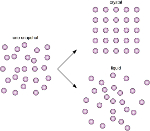News
EPJ E Highlight - How red blood cells behave in crowded vessels
- Details
- Published on 26 April 2019

A new model of red blood flowing through narrow capillaries shows that the cells change shape and alignment, allowing plasma to flow down the sides
Blood consists of a suspension of cells and other components in plasma, including red blood cells, which give it its red colour. When blood flows through the narrowest vessels in the body, known as the capillaries, the interactions between the cells become much more important. In a new study published in EPJ E, a team of researchers led by Ignacio Pagonabarraga from the University of Barcelona, Spain, has now developed a mathematical model of how red blood cells flow in narrow, crowded vessels. This could help design more precise methods for intravenous drug delivery, as well as 'microfluidic chips' incorporating artificial capillaries, which could offer faster, simpler and more precise blood-based diagnoses.
EPJ Plus Managing Editor Martine Ben Amar wins Huy Duong Bui prize
- Details
- Published on 23 April 2019

Professor Martine Ben Amar (Sorbonne Université, Paris), Managing Editor of EPJ Plus, is the 2018 recipient of the Huy Duong Bui prize - attributed by the French Academy of Sciences for outstanding work in the fields of Mechanics, Computer Science and Astrophysics - for her pioneering work on continuum mechanical models of biological systems.
The publishers and the EPJ Plus journal team congratulate Martine Ben Amar on this prestigious achievement.
EPJ Data Science Highlight - Offline biases in online platforms
- Details
- Published on 09 April 2019

Online booking platforms such as Airbnb or Uber present themselves as and strive to be inclusive, but there is an increasing amount of both anecdotal and scientific evidence of discriminatory behavior among their users. In a study published in EPJ Data Science, researchers at University College London set out to evaluate interaction patterns within Airbnb, in an effort to understand the extent to which offline human biases influence affects their users.
Read the guest post by Giacomo Livan, Licia Capra, Weihua Li and Victoria Koh on the SpringerOpen blog
EPJ ST Highlight - Infinite number of quantum particles gives clues to big-picture behaviour at large scale
- Details
- Published on 09 April 2019

Scientists gain a deeper understanding of phenomena at macroscopic scale by simulating the consequences of having an infinite number of physical phenomena at quantum scale
In quantum mechanics, the Heisenberg uncertainty principle prevents an external observer from measuring both the position and speed (referred to as momentum) of a particle at the same time. They can only know with a high degree of certainty either one or the other - unlike what happens at large scales where both are known. To identify a given particle’s characteristics, physicists introduced the notion of quasi-distribution of position and momentum. This approach was an attempt to reconcile quantum-scale interpretation of what is happening in particles with the standard approach used to understand motion at normal scale, a field dubbed classical mechanics.
In a new study published in EPJ Special Topics, Dr J.S. Ben-Benjamin and colleagues from Texas A&M University, USA, reverse this approach; starting with quantum mechanical rules, they explore how to derive an infinite number of quasi-distributions, to emulate the classical mechanics approach. This approach is also applicable to a number of other variables found in quantum-scale particles, including particle spin.
EPJ D Highlight - Inner electrons behave differently in aromatic hydrocarbons
- Details
- Published on 09 April 2019

A new study explores how the characteristics of aromaticity affect the process of Auger decay
When an electron from one of the lower energy levels in an atom is knocked out of the atom, it creates a space which can be filled by one of the higher-energy electrons, also releasing excess energy. This energy is released in an electron called an Auger electron - and produces an effect known as Auger decay. Now, Guoke Zhao from Tsinghua University in Beijing, China and colleagues at Sorbonne University in Paris, France have studied the Auger effect in four hydrocarbon molecules: benzene, cyclohexane, hexatriene and hexadiene. These molecules were chosen because they exhibit different characteristics of aromaticity. The authors found that molecules containing pi bonds have a lower threshold for Auger decay.
EPJ B Highlight - Magnetic nanoparticles can 'burn' cancer cells
- Details
- Published on 03 April 2019

Magnetic hyperthermia is still a highly experimental cancer treatment, but new research shows that the therapy is tunable
Unfortunately, cancer isn’t simply a single disease, and some types, like pancreas, brain or liver tumours, are still difficult to treat with chemotherapy, radiation therapy or surgery, leading to low survival rates for patients. Thankfully, new therapies are emerging, like therapeutic hyperthermia, which heats tumours by firing nanoparticles into tumour cells. In a new study published in EPJ B, Angl Apostolova from the University of Architecture, Civil Engineering and Geodesy in Sofia, Bulgaria and colleagues show that tumour cells’ specific absorption rate of destructive heat depends on the diameter of the nanoparticles and the composition of the magnetic material used to deliver the heat to the tumour.
EPJ E Highlight - Liquid jets break up more readily on a substrate
- Details
- Published on 03 April 2019

Using computational models to investigate how liquid drops behave on surfaces
Whether we're aware of it or not, in day-to-day life we often witness an intriguing phenomenon: the breakup of jets of liquid into chains of droplets. It happens when it rains, for example, and it is important for inkjet printers. However, little is known about what happens when a liquid jet, also known as a liquid filament, breaks up on top of a substrate. According to a new study, the presence of a nearby surface changes the way the filament breaks up into smaller droplets. In a new paper published by Andrew Dziedzic at the New Jersey Institute of Technology in Newark, New Jersey, USA, and colleagues in EPJ E, computer simulations are used to show that a filament is more likely to break up near a surface.
EPJ D Highlight - Optimising proton beam therapy with mathematical models
- Details
- Published on 02 April 2019

New model improves our understanding of energy transfer in radiotherapy treatment plans by replacing 50-year-old parameters with more complex ones
Particle beam therapy is increasingly being used to treat many types of cancer. It consists in subjecting tumours to beams of high-energy charged particles such as protons. Although more targeted than conventional radiotherapy using X-rays, this approach still damages surrounding normal tissue. To design the optimum treatment plan for each patient, it is essential to know the energy of the beam and its effect on tumour and normal tissue alike. In a recent study published in EPJ D, a group of researchers led by Ramin Abolfath at the University of Texas MD Anderson Cancer Center, Houston, Texas, USA, put forward a new mathematical model outlining the effects of these beam therapies on patients' tissues, based on new, more complex, parameters. Using these new models, clinicians should be able to predict the effect of proton beams on normal and tumour tissue more precisely, allowing them to prepare more effective treatment plans.
EPJ B Colloquium - Cooperative magnetic phenomena in artificial spin systems: spin liquids, Coulomb phase and fragmentation of magnetism
- Details
- Published on 28 March 2019

Two-dimensional arrays of interacting magnetic nanostructures offer a remarkable playground for simulating, experimentally, lattice spin models. Initially designed to capture the low-energy physics of highly frustrated magnets, they quickly became a lab-on-chip platform to investigate cooperative magnetic phenomena often associated with classical frustrated magnetism.
This Colloquium paper from Nicolas Rougemaille and Benjamin Canals at the Institut NEEL (Univ. Grenoble, CNRS, France) reviews the many-body physics which can be visualized, directly in real space, through the magnetic imaging of artificial arrays of magnetic nanostructures. Particular attention is paid to classical spin liquid states, magnetic Coulomb phases and magnetic moment fragmentation. Other phenomena, such as complex magnetic ordering, charge crystallization and monopole-like excitations, are also described in light of the recent advances in the field.
EPJ A Highlight - A Liquid-Lithium Target for Nuclear Physics
- Details
- Published on 27 March 2019

A liquid-lithium target (LiLiT) bombarded by a 1.5 mA, 1.92 MeV proton beam from the SARAF superconducting linac acts as a ~30 keV quasi-Maxwellian neutron source via the 7Li(p,n) reaction with the highest intensity (5×1010 neutrons/s) available todate. We activate samples relevant to stellar nucleosynthesis by slow neutron capture (s-process). Activation products are detected by α, β or γ spectrometry or by direct atom counting (accelerator mass spectrometry, atom-trap trace analysis). The neutron capture cross sections, corrected for systematic effects using detailed simulations of neutron production and transport, lead to experimental astrophysical Maxwellian averaged cross sections (MACS). A parallel effort to develop a LiLiT-based neutron source for cancer therapy is ongoing, taking advantage of the neutron spectrum suitability for Boron Neutron Capture Therapy (BNCT) and the high neutron yield available.
Michael Paul et al. (2019), Reactions along the astrophysical s-process path and prospects for neutron radiotherapy with the Liquid-Lithium Target (LiLiT) at the Soreq Applied Research Accelerator Facility (SARAF), Eur. Phys. J. A 55: 44, DOI 10.1140/epja/i2019-12723-5





